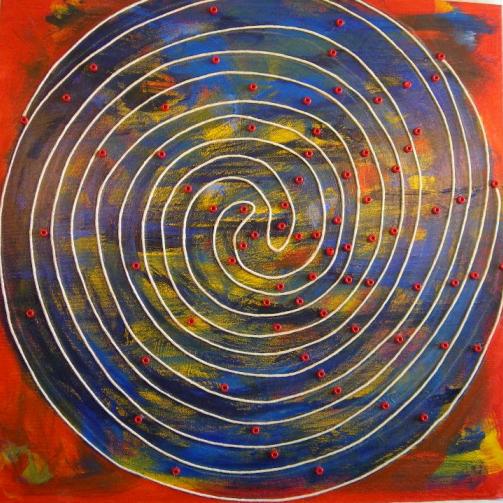Krystyna Laycraft |
"The Point Attractor #1"
Mixed Media on Canvas, 24”x24”, 2007.

One of the main concepts of Chaos Theory is an attractor. An
attractor is simply the characteristic behavior of a dynamical
system changing in time. The point attractor is the simplest way
to bring order out of chaos. It is a fixation on one desire or
addiction to drugs, to alcohol, to success, or to some ideas. It
leads to monotony, to misery, to depression, and very often to
death. It is a single-minded attractor: black or white, good or
bad, hate or love.
"The Cycle Attractor #2"
Mixed Media on Canvas, 24”x24”,2007.

To the group of periodic attractors belong a cycle attractor and a
torus attractor. The cycle attractor has the ability to resist
change. Both the point and the cycle attractors describe systems
that are highly regular, and thus, predictable. Routine is the
perfect life example for the cycle attractor: when we are
attracted to two activities, we tend to oscillate between them
(e.g., work and family). This state of life, when we are moving
from one situation to another, fluctuating from one mood to
another, and repeating the very same process again and again
brings only dissatisfaction and suffering.
"The chaotic attractor #3"
Mixed Media on Canvas, 24”x24”,2007.

The chaotic attractor describes systems that are in a state of
turbulence, such weather, violent river, brain activity, or our
life dynamics. In general, the chaotic attractors can take an
infinite number of different forms. Their patterns are fantastic,
complex maps that capture the interplay between stability and
change in a system. Essentially, a chaotic attractor is a process
that unfolds through the complex interactions between elements in
a system. It is through a pattern of folding and stretching that
the structure of the chaotic attractor emerges.
Krystyna Laycraft, Physicist/Artist
Center for Chaos Studies, Nanton, Alberta, Canada
"During the early eighties I worked as a physicist on some
nonlinear phenomena in astrophysics. This was a time when chaos
theory, nonlinear dynamics, fractals, and self-organization were
widely discussed and applied to a variety of physical, chemical,
and mathematical problems. Now, almost a quarter of a century
later, I apply Chaos theory to art and psychology. Through two
years (2006-2007) I created the series of paintings based on the
main concepts of Chaos theory like the bifurcation points and
attractors. Chaotic dynamics of human life have their own
evolutionary trajectories, described by attractors. In my work, I
examine peoples’ actions which are usually described by the point,
cycle or chaotic attractors. The mixed media techniques gave me
freedom and flexibility to express my ideas."